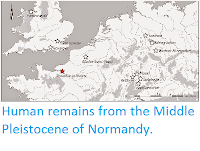Neanderthals were an archaic Human group that first appeared in Europe between 430 000 and 250 000 years ago. They were for a long time seen as more primitive than modern Humans, with a lower capacity for technology, little art or symbolism, and probably a much less sophisticated grasp of language, though this view has changed in recent decades, as they have been shown to have used more sophisticated tools than previously understood, as well as dyes for body art and even musical instruments, though cave painting has never been confidently added to this list of achievements.
In a paper published in the journal Science on 23 February 2018, a group of scientists led by Dirk Hoffmann of the Department of Human Evolution at the Max Planck Institute for Evolutionary Anthropology, describe the results of a study of cave art in Spain, which used uranium-thorium dating of flowstone deposits overlaying parts of the artwork to provide minimum dates for the paintings, which suggests that they are to old to be attributed to Modern Humans.
Flowstone is formed by the deposition of calcium carbonate onto surfaces by evaporating water; typically water that has flowed through limestone deposits then run out onto a surface such as a cave wall or cliff face before evaporating. The most obvious examples of this are stalagmites and stalactites, though many caves have an interior surfaces covered by flowstone. Where these flowstone deposits occur in caves with paintings they will often overlay the artwork, which means that if the flowstone can be dated, then a minimum age for the art can be established (as the art cannot be younger than the flowstone that overlays it).
Red scalariform sign, panel 78 in hall XI of La Pasiega gallery C. This panel features the La Trampa pictorial group. (Inset) Crust sampled and analysed for a minimum age, which constrains the age of the red line. Hoffmann et al. (2018).
Uranium-thorium dating works because uranium decays to thorium at a
known rate, so that the ratio of the two elements in minerals that
naturally incorporate uranium but not thorium can be used to establish a
date for the minerals. Neither uranium nor thorium are typically found in carbonate deposits, but uranium can be absorbed into these minerals as they form, whereas thorium cannot.
Hoffmann et al. sampled flowstone overlaying paintings in three caves, the La Pasiega Cave in the Monte Castillo Cave Art Complex World Heritage Site in Cantabria in the north of the country, the Maltravieso Cave in Extremadura in the west of the country, and Doña Trinidad Cave in Andalucia, in the south of the country.
Hand stencil GS3b in Maltravieso Cave. (Top) Original photo. The inset shows where the overlying carbonate was sampled. (Bottom) Same picture after application of the DStretch software (correlation LRE 15%, auto contrast) to enhance colour contrast. Hoffman et al. (2018).
The La Pasiega Cave is known to have been occupied for the much of the past 100 000 years, which it was occupied by first Neanderthals, who were present in the region until about 39 000 years ago, and then by Modern Humans, who first appeared in the region about 45 000 years ago. This means that any art younger than 39 000 years old must have been made by Modern Humans, while any art older than 45 000 years old must have been made by Neanderthals, with a period of about 6000 years in the middle where art could have been produced by either group.
The site contains a variety of paintings, predominantly in red and black, and including groups of animals, linear signs, claviform signs, dots, and possible anthropomorphs. Hoffmann et al. obtained samples of limestone from a flowstone deposit overlaying a ladder-like red symbol. This contained three distinct layers of material, with the innermost layer yielding an age of 64 800 years, roughly 20 000 years too old to have been produced by Modern Humans.
Speleothem curtain 8 in section II-A-3 in Ardales Cave with red pigment. (Left) Series of curtains with red paint on top, partially covered with later speleothem growth.The white rectangle outlines the area shown at right. (Right) Detail of curtain 8.The black square indicates where carbonate, overlying the red paint, was sampled. Hoffman et al. (2018).
The Maltravieso Cave is thought to have been occupied intermittently from about 160 000 years ago onwards, which again implies that it was occupied sequentially by first Neanderthals and then Modern Humans. This cave contains about sixty hand stencils, as well as geometric shapes and Human figures. Hoffmann et al. obtained a series of samples from carbonate deposits overlaying a red hand stencil, with the oldest yielding a minimum age of 66 700 years, again too old for the painting to have been produced by Modern Humans.
The Doña Trinidad Cave has not previously been dated, but has produced artifacts associated with the Middle and Late Palaeolithic, technologies associated with both Modern Humans and Neanderthals. The cave has numerous paintings, including hand stencils, geometric shapes and animal figures. Hoffmann et al. obtained samples from a flowstone curtain overlaying an area of cave wall that had been painted red, yielding ages of between 32 100 and 63 700 years, again implying that painting on the cave wall began long before modern Humans arrived in Iberia.
See also...
Follow Sciency Thoughts on Facebook.










